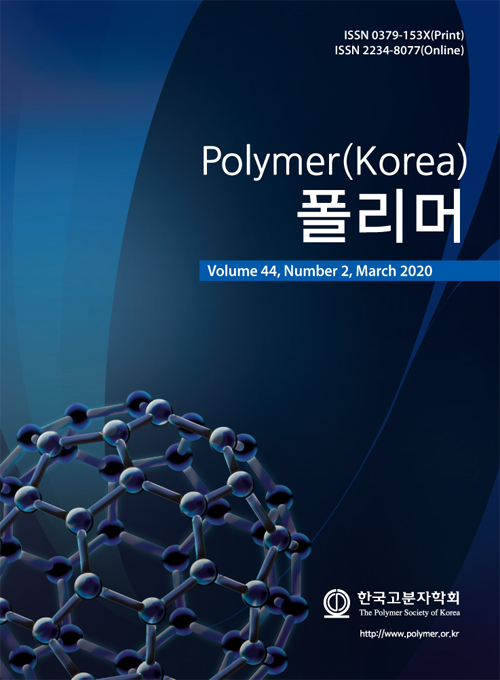- Effects of High Temperature Treatment on the Microstructure of Poly(phenylene sulfide) Film
Department of Organic Materials and Fiber Engineering, Soongsil University, Seoul 06978, Korea
- 고온 열처리가 폴리페닐렌 설파이드 필름의 미세구조에 미치는 영향
숭실대학교 유기신소재·파이버공학과
Effects of the heat treatment
at 220 oC for up to 17 days on the microstructure of
poly(phenylene sulfide) (PPS) films prepared by melt compression of virgin PPS
resins of high linearity were analyzed by using color difference analyzer,
X-ray photoelectron spectroscope (XPS), FTIR spectrometer, difference scanning
calorimeter, and X-ray diffractometer. As the heat treatment time increased,
the color of the PPS film gradually turned brown and the color difference
between heat-treated and untreated sample increased. XPS and FTIR analysis
confirmed that heat treatment caused thermal oxidation, followed by
cross-linking of the PPS chains. The heat treatment moved the first melting
temperature during the first DSC heating scan to a higher temperature while the
second melting temperature remained almost constant. However, the melt
crystallization temperature during the cooling scan was lowered by heat
treatment. Although the heat of melting increased and the heat of melt
crystallization decreased with the heat-treatment time, the crystal structure
of PPS was not affected by the heat treatment
220 oC에서 17일까지의 열처리가 선형성이 큰 순수 폴리페닐렌
설파이드(PPS) 수지를 용융압착하여 제조한 PPS 필름의
미세구조에 미치는 영향을 색차분석기, X-선 광전자 분광분석기(XPS),
FTIR 분광분석기, 시차주사열량계, X-선
회절분석기를 사용하여 분석하였다. 열처리시간이 길어짐에 따라 PPS 필름은
점차 갈색으로 변하였으며 미열처리 시료와의 색차가 커졌다. XPS와
FTIR 분석 결과, 열처리에 의해 PPS 분자사슬
사이에 산화가교가 되었다가 이어서 벤젠링 가교가 형성되었다. 열처리에 의해 DSC 1차 승온 시의 첫 번째 용융온도는 높아졌지만 두 번째 용융온도는 거의 비슷하였으며, 용융 후 강온 시의 용융결정화 온도는 낮아졌다. 또한 열처리시간이
길어지면 승온 시의 용융열은 증가하고 강온 시의 용융 결정화열은 감소하는 경향을 나타내었지만, 열처리에
의해 PPS 결정구조가 변하지는 않았다.
Keywords: poly(phenylene sulfide) film, heat treatment, microstructure, color difference, X-ray photoelectron spectroscopy
- Polymer(Korea) 폴리머
- Frequency : Bimonthly(odd)
ISSN 0379-153X(Print)
ISSN 2234-8077(Online)
Abbr. Polym. Korea - 2023 Impact Factor : 0.4
- Indexed in SCIE
 This Article
This Article
-
2020; 44(2): 177-185
Published online Mar 25, 2020
- 10.7317/pk.2020.44.2.177
- Received on Nov 8, 2019
- Revised on Dec 27, 2019
- Accepted on Jan 3, 2020
 Correspondence to
Correspondence to
- Young Ho Kim
-
Department of Organic Materials and Fiber Engineering, Soongsil University, Seoul 06978, Korea
- E-mail: ssyhkim@ssu.ac.kr










 Copyright(c) The Polymer Society of Korea. All right reserved.
Copyright(c) The Polymer Society of Korea. All right reserved.